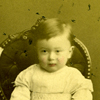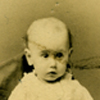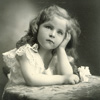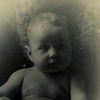Click on an image for a larger view
In studying photographs of infants and toddlers in the 19th
century, it is often difficult to discern a child’s gender. Choice
of clothing and hairstyle varied little between boys and girls,
and a child was typically considered ‘genderless’ for the first
few years of his or her life. As a result, the male infants in
these photographs may easily be mistaken for girls. With long,
light-colored garments and shoulder-length hair, the children appear
androgynous. The lines between the two genders became more defined
around the age of 6, when boys began to play together outside the
home and girls stayed inside to hone domestic skills.
The American idea of childhood and childrearing shifted several times throughout the 18th and 19th centuries. Clothing and furniture specifically manufactured for children also changed to match society’s transition into a new era of parenting. In the 1800’s, children’s furniture was designed primarily to contain infants within their world separate from that of adults. Often, the chairs and tables provided for infants were miniature versions of the furniture found in the rest of the home. In photographs of the time, children are often pictured on this type of child-friendly furniture. A feature unique to photographs of infants is the realism of their facial expressions. While older children could be coaxed into maintaining a look desired by their parents, children such as those seen on this page appear significantly more natural. |






